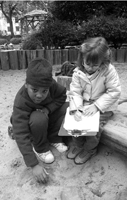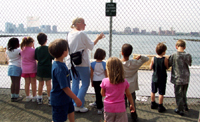Amy and Barbara Lieberman, the assistant teacher, had begun to incorporate documention practices in their work with the children. While Amy asked the children to reflect, Barbara captured verbatim what the children said. Later, when Amy and Barbara revisited the transcript of this conversation they noticed how the children kept turning to the topic of building a memorial to the World Trade Center at Ground Zero. The children seemed more captivated by connections to the social, emotional, and political issues that were buzzing around their homes and communities than the more generic study of parks and playgrounds Amy had planned. The teachers wanted to find a way to support the children in exploring the topic further. They approached Brigid McGinn, the studio teacher, thinking that the art studio would be a good environment for the children to delve deeper. Amy shared her documentation of the conversations with Brigid.
Documentation Examples > Examples of documentation that is shared more widely
For Children, By Children: The World Trade Center Memorial Park
School: Corlears School, Chelsea, New York City
3. Reflecting on Documentation
Brigid noticed how the children's thoughts and feelings were being filtered through the adults in their world, perhaps in an effort to give their ideas more credibility. These adult concerns seemed less accessible to the children and Brigid wanted to help them find their own place in this civic dialog. The question that emerged for her upon reading the transcript was, "What about the children? What do they think a World Trade Center Memorial should be like?"
Brigid had been watching for an opportunity to engage the children's perceptions, feelings, and ideas around the 9/11 attacks. It was such a monumental and life-changing event, especially for New Yorkers, that it seemed appropriate to make room for it in their school. When the teachers approached her with their documentation, she saw an opening for such an inquiry.


